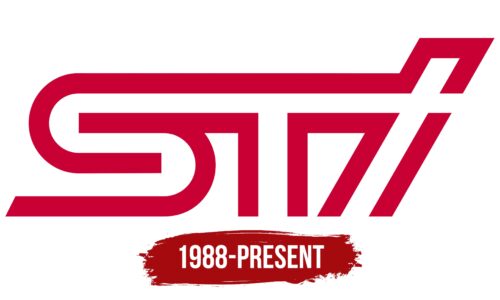The STI logo reflects confidence enhanced by creativity, better embodying the Japanese automobile company’s concept. The emblem conveys the vehicles’ high performance, reliability, speed, agility, and exclusivity.
STI: Brand overview
| Founded: | April 2, 1988 |
| Founder: | Ryuichiro Kuze |
| Headquarters: | Osawa, Mitaka, Tokyo, Japan |
| Website: | sti.jp |
In 1988, Subaru introduced its motorsports division, Subaru Tecnica International (STI). This division was created primarily to bolster Subaru’s presence in the World Rally Championship arena. Under the watchful eye of its founder, Ryuichiro Kuze, STI played a pivotal role in fine-tuning Subaru’s Impreza and Legacy models throughout the 1990s, prepping them for rally racing. Notable creations from STI’s stables include the celebrated Subaru Impreza WRX STI and the Subaru Legacy RS.
While STI’s core focus was racing vehicles, it wasn’t limited to that. By 1994, the division had begun to roll out performance-enhanced parts, accessories, and exclusive road vehicles for fans, with the WRX STI Version I as a prime example. Their success on the racing circuit and performance-centric models solidified Subaru’s reputation as a premier Japanese performance car manufacturer.
However, the landscape changed in the 2000s. Subaru’s interest in the World Rally Championship began to wane, prompting STI to recalibrate its focus towards crafting road-worthy performance models for everyday consumers, with the Impreza WRX STI taking the limelight. Over time, the newer iterations of STI performance cars, rooted in the WRX STI lineage, leaned more towards track performance than their rally origins.
Today, STI continues to embody Subaru’s dedication to speed and performance. The division persistently channels its motorsports experience into crafting Subaru’s most exhilarating street-legal vehicles.
Meaning and History
What is STI?
Since its founding on April 2, 1988, Subaru Tecnica International (STI), originally dubbed STi, has evolved into a revered brand in motorsports. Established by Ryuichiro Kuze, STI serves as the motorsports wing of the Subaru Corporation, operating from its main office in Osawa, Mitaka, Tokyo, Japan. For over thirty years, STI has gained recognition for its advanced engineering and meticulous craftsmanship, cementing its leadership position in the motorsports sector.
1988 – today
The STI emblem is entirely based on an abbreviation that represents the company’s concept and the technical characteristics of its cars. This is conveyed harmoniously with a few strokes in an unobtrusive and understandable form. The abbreviation’s meaning is straightforward:
- S – Subaru (indicating the direct connection of this manufacturer with the well-known corporation, as it is a project of theirs);
- T – Tecnica (representing the segment in which the company operates, offering various types of cars);
- I – International (demonstrating the brand’s presence in the global market and its wide popularity).
Although there are only three letters, they form a cohesive composition, emphasizing the unity of all divisions, their involvement in a common cause, and their focus on collective success. The glyphs also express the durability and reliability of the cars. They flow into each other harmoniously, sometimes becoming parts of each other.
For example, the top of the “T” is formed from the upper half of the “S” and the dot above the “i.” The designers have presented this so skillfully that one can marvel at their creativity and the smooth transition of ordinary lines. Upon close inspection, you can notice that the emblem consists of four components of different shapes: two are very simple, containing a single stroke (straight or curved), and two are complex (the line makes several turns).
The lowercase “i” stands out, as the other symbols are uppercase. Additionally, it is italicized, while the other two letters are not. This approach adds dynamism to the logo, which is important for an automotive company that includes racing cars in its lineup. The vibrant red color also conveys the boundless energy of the technology. It stands out clearly against the white background.




